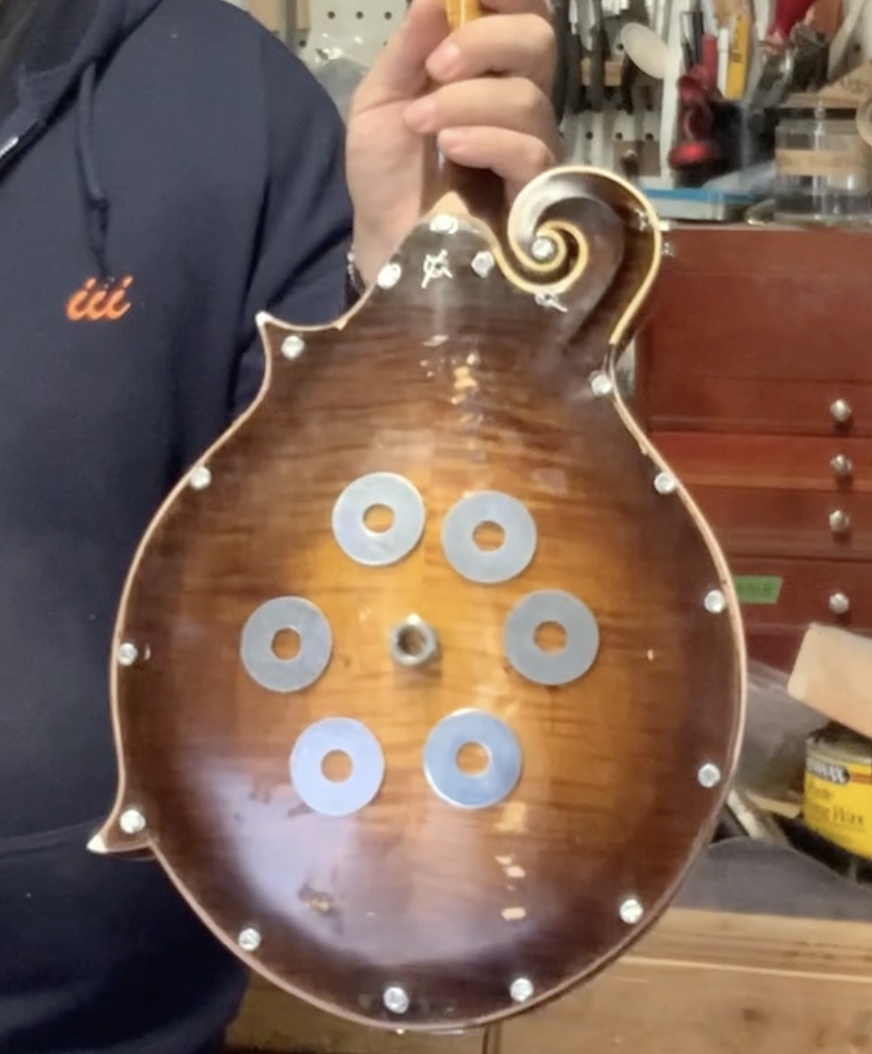Back Mass/Stiffness Tests p.2
Part 2 of this battery of tests deals with adding mass to the back.
I wanted to add mass but not stiffness, so I took a series of dense metal washers (and one nut) and used poster putty to attach them to the back. One is in the center and the rest in a circle around that, roughly halfway between the rim and center. The are not connected so as to not add stiffness and they are spread around so as to spread the mass evenly.
Here’s the numbers for the changes in resonances:
The % difference column shows that these are unreasonable changes if one is pursuing ideal tone. A 10% increase in overall mass and 50% increase to one part is an extreme difference. It is illustrative, though, of how adding mass to one part impacts the parts with which it is coupled. I would not suggest adding this much mass to any part of your instrument!
Tone Results
The tone overall sounds cleaner, smoother… like a smooth glass of milk vs a fizzy soda. One might also describe it as having a damp blanket laid right over it! The mids to highs seem choked out, especially e string above fret 5, loses all power. Overall there is a loss of brilliance/polish, creating a very close sound, not quite nasally, but sounds like it is right next to the ear. There is very little air or space in this tone. A little bit of tubbiness in the bass, sounds fat, like there's no edge to it. No real bubbly pop at all, overall more dry, favoring the low notes. Zero power on the D string, the A string is pretty muted too. Also high notes really need to dig to get anything out of them. Overall I'd say this is a great way to kill the tone of this mandolin, and probably any mandolin!
This all suggests that mass in the back in this situation acts as a tone control that filters out the high and highest frequencies and compresses the mids and lows, leaving the sound to be smooth, “close”, with less air, less volume and less bite. In other words, a damper— which is not surprising but interesting to take to an extreme case.
Further study of this would involve smaller changes to mass and paying attention to the location of that mass and which resonant patterns are affected. Another question to pursue would be that of added mass in the form of thickness, which would alter the stiffness as well and be more realistic on a building front— if you take a thick back and reduce it’s thickness you remove mass (raising resonances) and decrease stiffness (lowering resonances)— so do these changes cancel each other out or is one more powerful than the other? I have my own anecdotal answer to this but am looking forward to putting numbers on it.
Side-note: On one of my personal mandolins I’ve put 4 rare-earth magnets on the back, 2 inside and 2 outside that attract each other strongly and hold each other in position. I can move them around and attain different tones, in a surprisingly easy way! It can be subtle but sometimes not subtle for particular things and is definitely an interesting thing to try. I’ve found the “shape” (for lack of a better word) of the chop tone can be altered quite a bit by just moving the masses closer and further from the center— this corresponds to changes in frequency specific output too, so I don’t always leave them in one position. If I ever settle on one particular arrangement I like I can always glue that amount of mass in that spot inside and I’ll have a permanent change that is invisible. This is a pretty cheap and entertaining way to play around with tone that anyone can do!


